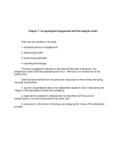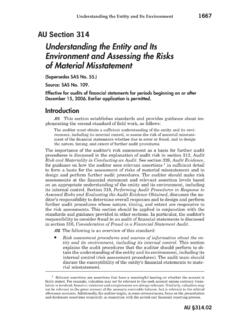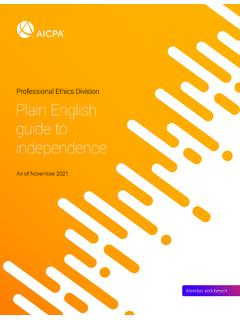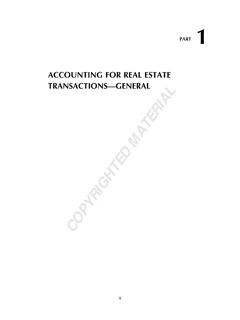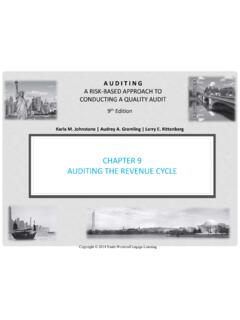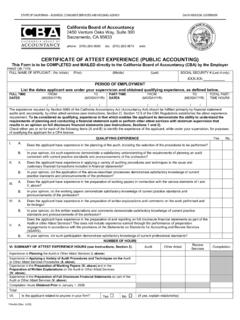Transcription of Auditing and Attestation (AUD) AICPA Released Questions - …
1 Auditing and Attestation (AUD) AICPA Released Questions - 2021 Material from Uniform CPA Examination Selected Questions and Unofficial Answers, 2021, copyright by American Institute of Certified Public Accountants, Inc., is reprinted and/or adapted with permission Note: Any knowing solicitation or disclosure of any Questions or answers included on any CPA examination is prohibited Multiple Choice Question #1: Each of the following is a required characteristic of a review engagement of management's discussion and analysis (MD&A), except: A. It consists principally of applying tests of details through inspection, observation, and confirmation. B. The practitioner applies analytical procedures. C. An objective is to report if any information came to the practitioner's attention that the MD&A is not reasonably presented.
2 D. The practitioner makes inquiries of individuals responsible for financial matters. Correct Answer: A Multiple Choice Question #2: Banister, a CPA, is approached by Wagner, a client. Wagner requests that Banister return the records provided to Banister by Wagner during an audit. Wagner still owes Banister the fees associated with the audit. According to the AICPA Code of Professional Conduct, what should Banister do? A. Banister should return the records to Wagner. B. Banister should return the records to Wagner only after the fee has been paid. C. Banister should not return the records to Wagner because the records now belong to Banister. D. Banister should not return the records to Wagner without a court order. Correct Answer: A Multiple Choice Question #3: An accountant's working papers for an engagement to review the financial statements of a nonpublic entity would be least likely to include which of the following forms of documentation?
3 A. Study and evaluation of internal control. B. Explanation of analytical procedures performed. C. A copy of the engagement letter. D. Copies of representation letters from client management. Correct Answer: AMultiple Choice Question #4: If differences of opinion arise between the engagement partner and the engagement quality control reviewer, then the engagement partner should A. Follow the firm's policies and procedures for resolving differences of opinion. B. Issue a disclaimer of opinion and report the issue to the entity's audit committee. C. Discuss the differences of opinion with the entity's management and issue a modified auditor's report. D. Withdraw from the engagement when permissible under law or regulation. Correct Answer: AMultiple Choice Question #5: An accountant is reviewing the financial statements of a nonpublic entity in accordance with Statements on Standards for Accounting and Review Services (SSARS).
4 The accountant most likely would perform which of the following procedures? A. Obtain an understanding of the internal control structure. B. Make inquiries about subsequent events. C. Send bank account confirmations. D. Perform limited tests of controls. Correct Answer: B Multiple Choice Question #6: Which of the following factors would an auditor most likely consider in evaluating the control environment for an audit client? A. Monthly bank reconciliations with supervisor sign-offs. B. The ethical values demonstrated by management. C. Organizational structure used for tax purposes. D. The number of employees in each department. Correct Answer: B Multiple Choice Question #7: Which of the following factors represents an inherent limitation of internal control? A. Absence of segregation of duties. B. Failure to perform required tasks. C. Mistakes resulting from human error.
5 D. Inadequate provisions to safeguard assets. Correct Answer: C Multiple Choice Question #8: When conducting a review engagement of a nonissuer, each of the following is considered an analytical procedure, except a comparison of the current-year's financial information to A. Expectations developed by the accountant. B. Financial statements of a comparable prior period. C. Supporting documentation. D. Industry benchmarks. Correct Answer: C Multiple Choice Question #9: As part of risk assessment procedures for an audit of a nonissuer, an auditor would most likely perform which of the following procedures concerning related-party transactions? A. Evaluate the entity's procedures for identifying related-party transactions. B. Confirm related-party transaction amounts and terms with the other party. C. Perform a direct test of related-party account balances.
6 D. Examine receiving and shipping records between the client and its affiliates. Correct Answer: A Multiple Choice Question #10: Which of the following applications of sampling to test controls is most appropriate? A. Testing a sample of customer orders for evidence of credit approval. B. Testing a sample of controls to determine segregation of duties between inventory control and sales processing duties. C. Testing a sample of accounts receivable confirmations. D. Testing a sample of the budget center directors' allocation of annual budget to sales units. Correct Answer: A Multiple Choice Question #11: When evaluating the impact of potential litigation, an auditor of a nonissuer should obtain audit evidence about each of the following, except A. The period in which the underlying cause for legal action occurred. B. The probability of an unfavorable outcome.
7 C. The probability that the matter will require a trial in court. D. The amount or range of potential loss. Correct Answer: C Multiple Choice Question #12: If a subsequent event occurs after the report date but prior to the release date of an audit report, resulting in management's revision of the financial statements of a nonissuer, then the auditor may do any of the following, except A. Maintain the original date of the report and state that the opinion is limited to the financial statements as they existed prior to the subsequent event. B. Perform audit procedures necessary to obtain assurance about the revised financial statements. C. Include an additional date in the audit report that is limited to the revision to the financial statements. D. Revise the date of the audit report to reflect the necessity of additional audit procedures. Correct Answer: A Multiple Choice Question #13: A client holds a debt security that is actively traded in the market.
8 Which of the following indicators would be the preferable guide to the security's fair market value? A. Published price quotations in the market. B. The price at which the debt security was purchased. C. The cash flow model using discounted future cash flows. D. Matrix pricing, in which published price quotations of similar debt securities are used to compute the fair market value. Correct Answer: A Multiple Choice Question #14: Which of the following most likely would be considered a mitigating condition concerning an entity's ability to continue as a going concern? A. Plans to increase ownership equity. B. Recent strong showing of the stock market. C. Positive comments about the company from industry analysts. D. A decreasing unemployment rate in the entity's industry. Correct Answer: A Multiple Choice Question #15: Whose signatures should be included in the management representation letter to the auditor?
9 A. President and chief financial officer. B. Chairman of the audit committee and chief operating officer. C. Corporate secretary and treasurer. D. Chief information officer and chief operating officer. Correct Answer: A Multiple Choice Question #16: An accountant who is engaged to issue a compilation report on one or more specified elements, accounts, or items of a financial statement A. Must adhere to the compilation performance requirements contained in the Statements on Standards for Attestation Engagements. B. Should attest whether such compiled elements, accounts, or items of a financial statement are free of material errors. C. Should not describe the basis on which the accounts are presented if that basis is other than generally accepted accounting principles. D. Can issue the report for an entity of which the accountant is not independent.
10 Correct Answer: D Multiple Choice Question #17: Which of the following is a correct statement regarding reporting on reviewed financial statements for a nonissuer? A. An accountant who is not independent is allowed to issue a review report as long as the accountant discloses the lack of independence in the review report. B. The date of the accountant's review report should be the day the accountant discusses the draft report with management. C. Reviewed financial statements must be prepared in accordance with generally accepted accounting principles. D. An accountant is allowed to issue a review report on the balance sheet only and not on the other related financial statements as long as the scope of inquiry and analytical procedures were not restricted. Correct Answer: D Multiple Choice Question #18: Under which of the following circumstances would an auditor most likely issue either a qualified or a disclaimer of opinion?




